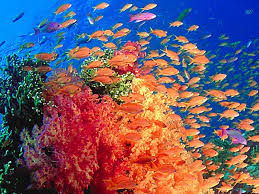 Light behaves differently on dry land than it does underwater and that is why you need a special strategy when taking underwater photos. Underwater photographers have to be trained SCUBA divers, plus they are faced with the unique photo lightning situation. The largest obstacle that they have to contend with is the significant loss of contrast and color. As we know, sunlight is composed of several different colors and orange and red, the colors of longer wavelength become absorbed by the water quickly and that is why the rest of the light looks blue. With the distance, no matter is it horizontal or vertical, the loss of colors increases. This means that you can be 2 m under water, but if your object is 30 m away from you, it will appear colorless. Yes, even if the water is as clear as possible. So, how to overcome these problems? It’s up to underwater photographers to find the way to solve this issue and here are three simple tips that might be helpful to you.
Light behaves differently on dry land than it does underwater and that is why you need a special strategy when taking underwater photos. Underwater photographers have to be trained SCUBA divers, plus they are faced with the unique photo lightning situation. The largest obstacle that they have to contend with is the significant loss of contrast and color. As we know, sunlight is composed of several different colors and orange and red, the colors of longer wavelength become absorbed by the water quickly and that is why the rest of the light looks blue. With the distance, no matter is it horizontal or vertical, the loss of colors increases. This means that you can be 2 m under water, but if your object is 30 m away from you, it will appear colorless. Yes, even if the water is as clear as possible. So, how to overcome these problems? It’s up to underwater photographers to find the way to solve this issue and here are three simple tips that might be helpful to you.
Come as close as you can to the subject. Yes, this is not strictly a lightning tip, but it really has a lot of influence of the success of your underwater photo session. Light in the water has the tendency to fall of quite quickly and that is why it’s of high importance to be close to the subject in order to see it vividly. As a matter of fact, skilled and professional underwater photographer wouldn’t consider any distance of more than 1 meter to be well for a quality photograph. So, shoot close to your subjects and make sure you have wide angle and macro lenses.
Sunny days are great for underwater photo shooting. The largest source of light is the sun. This means that you will have less visibility on an overcast day than you would on a sunny one. This difference is not insignificant, since it has a lot of influence on the general look of the images. When you shoot on overcasts days, everything under the surface looks darker and that makes shooting job significantly harder. When you shoot on bright days, you overcome this problem.
Do not underestimate the power of the flash. Use camera’s flash and it will give your images a wonderful fill light. The flash will not only fill in the dark areas, but also some of the absorbed color will be restored. The images would have more vibrant colors as opposed to background looking very blue.

